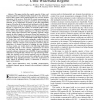73 search results - page 12 / 15 » On the Optimal Number of Active Receivers in Fading Broadcas... |
INFOCOM
2002
IEEE
14 years 10 days ago
2002
IEEE
Abstract— In [1], Gupta and Kumar determined the capacity of wireless networks under certain assumptions, among them point-to-point coding, which excludes for example multi-acces...
WCNC
2008
IEEE
14 years 1 months ago
2008
IEEE
—We study a cognitive network consisting of multiple cognitive users communicating in the presence of a single primary user. The primary user is located at the center of the netw...
CORR
2010
Springer
13 years 5 months ago
2010
Springer
Interference alignment is a transmission technique for exploiting all available degrees of freedom in the symmetric frequency- or time-selective interference channel with an arbit...
CORR
2010
Springer
13 years 5 months ago
2010
Springer
This paper is concerned with decentralized estimation of a Gaussian source using multiple sensors. We consider a diversity scheme where only the sensor with the best channel sends...
CORR
2007
Springer
13 years 7 months ago
2007
Springer
—This paper studies the ergodic capacity of time- and frequency-selective multipath fading channels in the ultrawideband (UWB) regime when training signals are used for channel e...

